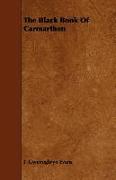- Start
- The Black Book of Carmarthen
The Black Book of Carmarthen
Angebote / Angebote:
Of such a nature are the questions and the request commonly addressed to the writer. What follows, therefore, is an attempt to satisfy this natural and reasonable curiosity on the part of the many, rather than a critical analysis addressed to the few. The latter work can be better performed by those who live within reach of great libraries, and of fellowworkers in divers branches of research. A solitary man, living in exile among mountains, remote from the centres of learning, must be content with inviting his readers to the nearest height, whereon he may show them the nature of the country, -perhaps name one or two of the more salient features, and gather, as he goes, a fev flowerets by the wayside. Teg yd gLn yr adaren ar berwy8 bren. 1079 Fair the birdie sings on the fragrant bough. Yes, fair the day, and fair the spot, and fair his lot who listens. What a wealth of suggestion is there in that word fair, in the forefront of the poem, while the tuneful adaren brings a whole world of blossom and new life before our vision, and fills our nostrils with the spring. Can, It is held to be the law of all literatures that they must begin with verse, before they go on to prose. The Black Book of Carmarthen is no exception to the rule. It was written by men of Deheubarth, whose accent may still be heard in the neighbourhood of its origin, the Priory of St. Johns, founded for Black Canons about the year 1148, at the east end of the town of Carmarthen. The Iriory itself is in the last stages of decay the very names of those who lived within its walls can only be traced now in the Book of Fate and of the work they did with their hands, there remains but the fragment which makes up the text of this booltlet, which was written during the reigns of Henry II., and his sons. Some of the compositions, however, belong to earlier ages. The Dialogues must be placed in this class, but before we examine them, it will be convenient to deal with the contents of our text, not in the sequence of the poems in the manuscript, but according to the four main divisions of the subject matter, to wit Mythology, Theology, History, and Literature. In the evolution of human thought and beliefs, we must not look for definite frontier-lines, and we do not find them in the Black Hook of Carmarthen. Its theology is not infrequently merged in the older mythology, as is only natural the younger is grafted on the older, which ever supplies the sap, and mothers the growth that overshadows it. Still, for the purpose of our present examination the above divisions are sufficiently distinctive, and they will be followed in the order named.The Dialogues are fell of mythological and semi- Dla. historical allusions, and for that reason are often very logues, obscure to the modern mind. The language offers difficulties, but wherever the subject is understood the words yield their meaning readily. The real difficulty lies in the subject itself, as a rule.......
Folgt in ca. 15 Arbeitstagen
